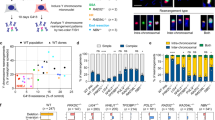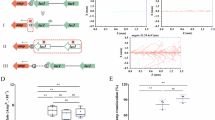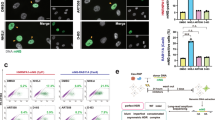Abstract
The faithful repair of DNA damage, especially chromosomal double-strand breaks (DSBs), is crucial for genomic integrity. We have previously shown that securin interacts with the Ku70/80 heterodimer of the DSB non-homologous DNA end-joining (NHEJ) repair machinery. Here we demonstrate that securin deficiency compromises cell survival and proliferation, but only after genotoxic stress. Securin−/− cells show a significant increase in gross chromosomal rearrangements and chromatid breaks after DNA damage, and also reveal an altered pattern of end resection in an NHEJ assay in comparison with securin+/+ cells. These data suggest that securin has a key role in the maintenance of genomic stability after DNA damage, thereby providing a previously unknown mechanism for regulating tumour progression.
Similar content being viewed by others
Log in or create a free account to read this content
Gain free access to this article, as well as selected content from this journal and more on nature.com
or
Abbreviations
- Adr:
-
adriamycin
- BrdU:
-
bromodeoxyuridine
- CPT:
-
camptothecin
- DSB:
-
double-strand break
- GCR:
-
gross chromosomal rearrangement
- HR:
-
homologous recombination
- IR:
-
ionizing radiation
- MMS:
-
methyl methanesulphonate
- NHEJ:
-
non-homologous DNA end joining
References
Dominguez A, Ramos-Morales F, Romero F, Rios RM, Dreyfus F, Tortolero M et al. hpttg, a human homologue of rat pttg, is overexpressed in hematopoietic neoplasms. Evidence for a transcriptional activation function of hPTTG. Oncogene 1998; 17: 2187–2193.
Zhang X, Horwitz GA, Prezant TR, Valentini A, Nakashima M, Bronstein MD et al. Structure, expression, and function of human pituitary tumor-transforming gene (PTTG). Mol Endocrinol 1999; 13: 156–166.
Saez C, Japon MA, Ramos-Morales F, Romero F, Segura DI, Tortolero M et al. hpttg is over-expressed in pituitary adenomas and other primary epithelial neoplasias. Oncogene 1999; 18: 5473–5476.
Heaney AP, Singson R, McCabe CJ, Nelson V, Nakashima M, Melmed S . Expression of pituitary-tumour transforming gene in colorectal tumours. Lancet 2000; 355: 716–719.
Saez C, Martinez-Brocca MA, Castilla C, Soto A, Navarro E, Tortolero M et al. Prognostic significance of human pituitary tumor-transforming gene immunohistochemical expression in differentiated thyroid cancer. The J Clin Endocrinol Metab 2006; 91: 1404–1409.
Ramaswamy S, Ross KN, Lander ES, Golub TR . A molecular signature of metastasis in primary solid tumors. Nat Genet 2003; 33: 49–54.
Bernal JA, Luna R, Espina A, Lazaro I, Ramos-Morales F, Romero F et al. Human securin interacts with p53 and modulates p53-mediated transcriptional activity and apoptosis. Nat Genet 2002; 32: 306–311.
Difilippantonio MJ, Zhu J, Chen HT, Meffre E, Nussenzweig MC, Max EE et al. DNA repair protein Ku80 suppresses chromosomal aberrations and malignant transformation. Nature 2000; 404: 510–514.
Ferguson DO, Sekiguchi JM, Chang S, Frank KM, Gao Y, DePinho RA et al. The nonhomologous end-joining pathway of DNA repair is required for genomic stability and the suppression of translocations. Proc Natl Acad Sci USA 2000; 97: 6630–6633.
Gu Y, Seidl KJ, Rathbun GA, Zhu C, Manis JP, van der Stoep N et al. Growth retardation and leaky SCID phenotype of Ku70-deficient mice. Immunity 1997; 7: 653–665.
Gao Y, Sun Y, Frank KM, Dikkes P, Fujiwara Y, Seidl KJ et al. A critical role for DNA end-joining proteins in both lymphogenesis and neurogenesis. Cell 1998; 95: 891–902.
Romero F, Multon MC, Ramos-Morales F, Dominguez A, Bernal JA, Pintor-Toro JA et al. Human securin, hPTTG, is associated with Ku heterodimer, the regulatory subunit of the DNA-dependent protein kinase. Nucleic Acids Res 2001; 29: 1300–1307.
Jallepalli PV, Waizenegger IC, Bunz F, Langer S, Speicher MR, Peters JM et al. Securin is required for chromosomal stability in human cells. Cell 2001; 105: 445–457.
Pfleghaar K, Heubes S, Cox J, Stemmann O, Speicher MR . Securin is not required for chromosomal stability in human cells. PLoS Biol 2005; 3: e416.
Phillips JW, Morgan WF . Illegitimate recombination induced by DNA double-strand breaks in a mammalian chromosome. Mol Cell Biol 1994; 14: 5794–5803.
Liang F, Jasin M . Ku80-deficient cells exhibit excess degradation of extrachromosomal DNA. J Biol Chem 1996; 271: 14405–14411.
Kim DS, Franklyn JA, Smith VE, Stratford AL, Pemberton HN, Warfield A et al. Securin induces genetic instability in colorectal cancer by inhibiting double-stranded DNA repair activity. Carcinogenesis 2007; 28: 749–759.
Jallepalli PV, Waizenegger IC, Bunz F, Langer S, Speicher MR, Peters JM et al. Securin is required for chromosomal stability in human cells. Cell 2001; 105: 445–457.
Mei J, Huang X, Zhang P . Securin is not required for cellular viability, but is required for normal growth of mouse embryonic fibroblasts. Curr Biol 2001; 11: 1197–1201.
Arnaudeau C, Lundin C, Helleday T . DNA double-strand breaks associated with replication forks are predominantly repaired by homologous recombination involving an exchange mechanism in mammalian cells. J Mol Biol 2001; 307: 1235–1245.
Adachi N, So S, Koyama H . Loss of nonhomologous end joining confers camptothecin resistance in DT40 cells. Implications for the repair of topoisomerase I-mediated DNA damage. J Biol Chem 2004; 279: 37343–37348.
Ninomiya Y, Suzuki K, Ishii C, Inoue H . Highly efficient gene replacements in Neurospora strains deficient for nonhomologous end-joining. Proc Natl Acad Sci USA 2004; 101: 12248–12253.
Milne GT, Jin S, Shannon KB, Weaver DT . Mutations in two Ku homologs define a DNA end-joining repair pathway in Saccharomyces cerevisiae. Mol Cell Biol 1996; 16: 4189–4198.
Ayene IS, Ford LP, Koch CJ . Ku protein targeting by Ku70 small interfering RNA enhances human cancer cell response to topoisomerase II inhibitor and gamma radiation. Mol Cancer Ther 2005; 4: 529–536.
Gallego ME, Bleuyard JY, Daoudal-Cotterell S, Jallut N, White CI . Ku80 plays a role in non-homologous recombination but is not required for T-DNA integration in Arabidopsis. Plant J 2003; 35: 557–565.
Pourquier P, Pommier Y . Topoisomerase I-mediated DNA damage. Adv Cancer Res 2001; 80: 189–216.
Furuta T, Takemura H, Liao ZY, Aune GJ, Redon C, Sedelnikova OA et al. Phosphorylation of histone H2AX and activation of Mre11, Rad50, and Nbs1 in response to replication-dependent DNA double-strand breaks induced by mammalian DNA topoisomerase I cleavage complexes. J Biol Chem 2003; 278: 20303–20312.
Vance JR, Wilson TE . Yeast Tdp1 and Rad1-Rad10 function as redundant pathways for repairing Top1 replicative damage. Proc Natl Acad Sci USA 2002; 99: 13669–13674.
Nitiss J, Wang JC . DNA topoisomerase-targeting antitumor drugs can be studied in yeast. Proc Natl Acad Sci USA 1988; 85: 7501–7505.
Foray N, Priestley A, Alsbeih G, Badie C, Capulas EP, Arlett CF et al. Hypersensitivity of ataxia telangiectasia fibroblasts to ionizing radiation is associated with a repair deficiency of DNA double-strand breaks. Int J Radiat Biol 1997; 72: 271–283.
Lundberg R, Mavinakere M, Campbell C . Deficient DNA end joining activity in extracts from fanconi anemia fibroblasts. J Biol Chem 2001; 276: 9543–9549.
Thalhammer S, Koehler U, Stark RW, Heckl WM . GTG banding pattern on human metaphase chromosomes revealed by high resolution atomic-force microscopy. J Microsc 2001; 202 (Part 3): 464–467.
Acknowledgements
We are grateful to AD Jeyasekharan for helping in the English edition of the manuscript, and to B Vogelstein for HCT116 sec−/− cells, to J Sánchez for advice on chromosomal analysis and M Shivji for critical reading of the manuscript. JAP-T and MT were supported by grants from the Spanish Ministerio de Ciencia y Tecnología and the DGUI of the Junta de Andalucía. CM-V is a recipient of a postdoctoral contract (Program Juan de la Cierva) from the Spanish Ministerio de Educación y Ciencia.
Author information
Authors and Affiliations
Corresponding author
Additional information
Edited by M Oren
Supplementary Information accompanies the paper on Cell Death and Differentiation website (http://www.nature.com/cdd)
Supplementary information
Rights and permissions
About this article
Cite this article
Bernal, J., Roche, M., Méndez-Vidal, C. et al. Proliferative potential after DNA damage and non-homologous end joining are affected by loss of securin. Cell Death Differ 15, 202–212 (2008). https://doi.org/10.1038/sj.cdd.4402254
Received:
Revised:
Accepted:
Published:
Issue date:
DOI: https://doi.org/10.1038/sj.cdd.4402254
Keywords
This article is cited by
-
EZH2 cooperates with E2F1 to stimulate expression of genes involved in adrenocortical carcinoma aggressiveness
British Journal of Cancer (2019)
-
Does securin expression have significance in prognostication of oral tongue cancer? A pilot study
European Archives of Oto-Rhino-Laryngology (2016)
-
Pathogenesis of pituitary tumors
Nature Reviews Endocrinology (2011)
-
Pituitary tumor transforming gene 1 regulates Aurora kinase A activity
Oncogene (2008)



